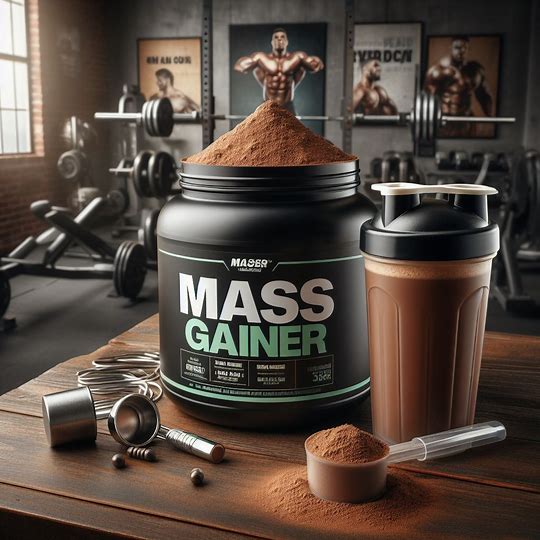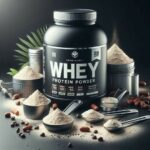Answer: The reason mass gainers only have 8 servings (and has low amounts of servings in general) is because the serving sizes are so big. They are so big because a bigger serving size means more calories, protein, carbs and fats, and that the caloric surplus is maintained. A bigger serving size means that there will be less of the overall product to use, and there will be less servings in general.

Key takeaways
- Mass gainer has such a large serving size because it is intended to maximise calories, protein and carbs.
- Breaking down the massive serving size into smaller portions throughout the day makes it easier to consume the whole serving in one day
- Protein powder can replicate the protein aspect of mass gainer, but falls short when it comes to calories and carbs
- Mass gainer has a cheaper upfront cost, but the price per serving can get quite expensive
Why it’s so small
Mass gainers have such a small amount of servings because the serving sizes themselves are massive. The serving sizes can be around 340 grams!
That is a massive size, whereas the serving size for protein powder for example is around 30g. Mass gainer serving sizes are more than 10 times larger than protein powder.
Mass gainers are intended to help individuals bulk. With bulking, the goal is to remain in a caloric surplus to maximise muscle growth, so you’ll need to be eating more calories than usual. Mass gainers have such a large serving size because we want to maximise the amount of calories we can get from it. There is a larger focus on the overall amount of calories and protein, rather than just protein itself.
Think of it like a ‘bulking supplement’, rather than a ‘protein supplements’. A bulking supplement is more so focused on bulking (caloric surplus), so both protein and calories will be the focused. Carbohydrates will also have a focus as well. The protein content could go up to 40%, which is not too high when you compare to protein powder (Can go up to 95%).
Therefore, a larger serving will mean more calories and protein, helping you to stay in that ‘surplus’ zone.
With one serving, you can get up to 1250 calories, 50 grams of protein and 250 grams of carbohydrates. That screams bulking. You get more than enough calories to bulk, a good amount of protein to build/maintain muscle and you get a bunch of carbs to fuel your workouts for growth.
If manufacturers were to put 30 servings instead of 8, with the serving sizes being around 40g, then the benefits to your bulk would be reduced. For example, if the 340g serving was reduced to 50g, this is what the macros would look like.
1252 calories is reduced to 187
50g protein is reduced to 7.5g
254g of carbs is reduced to 38g
The macros are much less appealing than before. Not many people, including myself and maybe even you reading this, wouldn’t even choose mass gainers if those were the macros. That is why the serving size is so massive, as it is purely designed for bulking and maximising your calories in a day.
Not all mass gainers have 8 servings per tub. The amount of servings will depend on the manufacturer, their own designated serving size and the overall size of the product you’ve product. A 2.72kg tub may have 8 servings, but a 5.44kg tub could have 16. As you can see, there is a stark difference in the amount of servings.
Additionally, the serving sizes on on each manufacturer can vary greatly. Sizes can range from the following; 80g, 90g, 100g, 160g, 200g, 338g and 350g. Just from this list, there is a 270g difference from the smallest size and the largest size.
As the serving size gets bigger, there is naturally less servings per tub. Moreover, some tub sizes can go up to 8kg. The least is around 8 (servings), with the most around going up to 30.
However, this all depends on the tub size itself and the specified size of the servings.

How you can maximise the servings
At times, manufacturers have their own directions for mass gainers. Some manufacturers suggest that you should do the following:
- have their mass gainer right after training
- Mix it into a blender or with just water/milk
- Starting off with just ½ serving.
- Having it with at different times throughout the day
The best way for most people is to start off with a smaller serving size. A serving size that you’d normally use with protein powder is a good start. This way you can gauge how you feel and then progress your size from there. Jumping straight into a 350g serving size may upset your stomach and would be too heavy on yourself.
The next suggestion is to break up the serving size into different portions throughout the day. For example, with a 350g serving size, that may be too big for you at a time (I know it would be too big for me). You could instead split it into 5 ‘70g’ servings. You could have it in the morning alongside your breakfast, then as a morning snack, then with your lunch, then as your afternoon snack and finally you could have it after your dinner. This way your still getting in 350g of mass gainer, just broken up into different times. I understand that 70g is a massive serving in itself, as it’s around double the normal size for most people, so you can cut down even more. The point is;
Whether you have it in one sitting, or at 5 times throughout the day, the difference does not matter.
Your next way is to blend it (as many manufacturers suggest). You may not like the texture/flavour alone of mass gainer. I know that mass gainer may not be as tasteful as other protein supplements, so blending it with ingredients (such as flavourful fruits) that have a stronger taste is an effective way to make you forget that you’re drinking mass gainer.
Consider the cost and price per serving
In general, mass gainers are cheaper than protein powders. I found this through comparing protein powders and mass gainer prices (bearing in mind the size) on the market.
However, when looking at the price per servings, mass gainer is actually more expensive. If you were to follow the exact serving size (and the amount of servings) that the mass gainer company has provided, mass gainer is considerably more expensive. This is because the serving size itself for mass gainers are very large, meaning that they’ll be less overall servings in a tub.
Of course, you could simply not follow the serving size. You could opt for a smaller serving size (for example, instead of following the 150g serving, you could do 80g instead. Following this means that your mass gainer will last you a longer amount of time).
Ultimately though, if you are going to buy mass gainer, the upfront cost will be cheaper than protein powder. However, if you are going to follow the exact serving size that they have provided, then your price per serving will be more expensive than protein powder and will last you a less amount of time.
How protein powder can be a substitute
When it comes to the protein amount, protein powder is a great substitute. It has a higher protein content (upwards to 95%) when you compare to mass gainers (around 40%). For bulking, you’ll need to make sure that you’re getting sufficient protein in, and protein powder can fill this spot when mass gainer isn’t available.
From an overall health perspective, protein powder would also be a good alternative. To create such a high-calorie supplement, many manufacturers include added carbohydrates and fats to up the caloric amount. These can come in the form of maltodextrin, dextrose, healthy oils and other easily added carbs/fats.
However, these ingredients are considered less healthy and reduce the overall health score of mass gainers. With protein powders, they can have less than four ingredients, with the only ingredients being the protein source, a flavouring, a sweetener and another ingredient. Naturally, this makes protein powder ‘healthier’ than mass gainers to most people. If I were to ask you to pick the healthier option, I would suggest protein powders.
Unfortunately, protein powder does fail in two areas as a substitute; the calories and carbs. To bulk, you’ll need to maintain a caloric surplus. With mass gainers, alongside their large serving size, they have a great emphasis on calories, carbs and protein. There is a shared importance of all three elements. Protein powder on the other hand, is highly focused on maximising the protein intake. If you were to make the serving sizes the same, mass gainers would have slightly more calories, with much more carbs.
Carbs are good because they provide your body with energy, which is needed to train hard and stimulate muscle growth. Protein powders do not provide this.
Yes, you can use protein powder as a substitute for mass gainer, but they won’t be able to replicate the calories and carbs that mass gainers emphasise.
You can make your own (Alternatives)
That being said, you can make your own mass gainer shake. You can use protein powder to ensure that the protein is high, but then add in other ingredients to increase carbs and calories. (Insert video)
Here are some ingredients you can use:
- 50g of your favourite protein powder
- Whole milk (up to 300ml)
- Frozen berries
- Frozen banana
- Peanut butter
- Greek Yoghurt
- Oats
- Spinach
- Kale
- Meusli
A classic is protein powder, milk, banana, berries, oats and Greek yoghurt.

